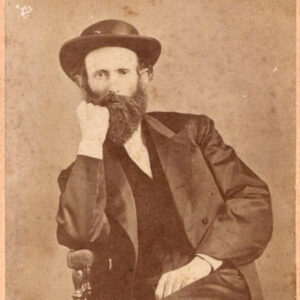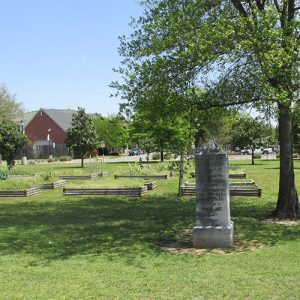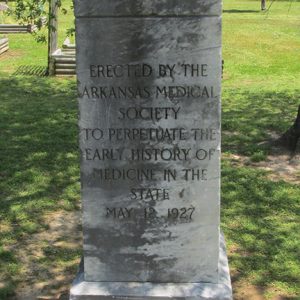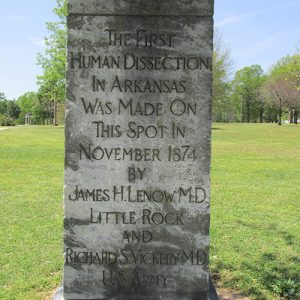calsfoundation@cals.org
Human Dissection Monument
The first human dissection performed in Arkansas is commemorated by an obelisk located at the edge of MacArthur Park in Little Rock (Pulaski County). In 1927, the Arkansas Medical Society unveiled the marker, whose inscription states that the dissection was held on that spot in November 1874. To clarify: the monument honors the state’s first such legal event, and the unveiling took place on May 13, despite the marker being dated May 12.
Following appeals by doctors, in April 1873 the Arkansas General Assembly passed Act 45 authorizing “dissection in certain cases for the advancement of science.” This paved the way for the establishment of a medical school, as the new law gave both doctors and medical students the right to possess bodies for use in anatomical studies and dissection. The act spelled out where these bodies could be “lawfully obtained”: any almshouse, prison, or house of correction or jail—places where bodies would be disposed of at public expense. Once dissected, the remains were to be “decently buried.”
The act also specified whose bodies could not be used: persons who had specifically requested burial, deceased persons whose friends or relatives wished to have the body buried, or anyone who “was a stranger who died suddenly before making himself known.” Some condemned men, about to be hanged, asked that their bodies not be given to doctors for dissection.
The prohibition against dissecting strangers appears to rule out the use of unidentified indigents’ bodies, but a history of the College of Medicine states that the students’ cadavers “were almost entirely those unknown transients” who died on land, near the river, or by violence in Little Rock. Though the cadavers used in anatomy class could be purchased from the college, grave-robbing by poorer students cannot be ruled out. The Arkansas Gazette reported on several suspected instances involving the remains of both African Americans and whites. When the Arkansas State Penitentiary’s cemetery, in Little Rock, was moved in 1893, a half dozen of the more than 300 unmarked graves were found to be empty, causing speculation that these bodies might have been removed by medical students.
Two U.S. Army doctors, James H. Lenow and Richard S. Vickery, are credited with performing the state’s first legal dissection. Vickery located a shed on the grounds of the Little Rock Barracks (today the site of MacArthur Park) in which they could work, while Lenow had access to bodies of deceased prisoners at the penitentiary. Lenow gave an account of the event in the Arkansas Medical Society’s journal in 1926: “About nightfall on or about November 1, 1874, I carried the first cadaver of a negro wrapped in a blanket and placed him beside me in my phaeton through this city and to this shed where Dr. Vickery and I spent the evenings of four or five weeks in this dissection. This possibly was the first dissection made in the State after the law was passed legalizing the same.”
Lenow claimed that medical schools in other states had commemorated similar events, and he chaired the Arkansas Medical Society’s committee to erect its own marker on the approximate location, on the west side of McMath Avenue. At the society’s convention the following year, Dr. J. M. Lemons, chairman of the Arkansas Medical Society, unveiled the marker, which was made by Little Rock monument company Monahan & Son.
Though this obelisk honors the legal landmark, the date of the actual first human dissection in Arkansas is unknown. One early event was described by Confederate surgeon Robert James Christie (Tenth and Twelfth Missouri Infantry). During the Civil War, in 1864, he and other doctors formed a medical society in their leisure time while stationed at Camp Bragg, near Camden (Ouachita County). As he described it: “A negro was killed by another a few miles from the camp….We used the subject for careful dissecting and operation. We did our dissecting in a log hut: the cracks were not chinked nor daubed, and to us, on the inside, it was an amusing sight to see a row of eyes peering through the cracks, trying to get a glimpse of the structure of the human form divine.”
It is not coincidental that both of these early accounts involve the dissection of black bodies; black residents of Little Rock believed that they were being targeted. In 1879, a shot was fired through a window at the medical college by someone supposedly upset by rumors that doctors were luring African Americans to their deaths in order to obtain cadavers. Little Rock’s Arkansas Gazette issued the tepid reassurance: “Medical colleges, rather than drawing subjects…chosen from the living, snatch them from graveyards.”
For additional information:
Acts of the General Assembly of the State of Arkansas, 1873. Little Rock Printing and Publishing Company, 1873.
Baker, Max L., ed., Historical Perspectives: The College of Medicine at the Sesquicentennial. Little Rock: Arkansas Sesquicentennial Commission, 1986.
“Clinic Held by Physicians.” Arkansas Gazette, May 13, 1927, p. 10.
“I’ll Shoot ’Em.” Arkansas Gazette, October 28, 1879, p. 8.
Journal of the Arkansas Medical Society 22 (April 1926): 231–232.
Journal of the Arkansas Medical Society 24 (July 1927): 34–37.
The Memoirs of Dr. Robert J. Christie (1831–1909), Chapter XVI. Online at http://flanaganfamily.net/genealo/memoirs.htm (accessed August 10, 2018).
Abby Burnett
Kingston, Arkansas
 Early Twentieth Century, 1901 through 1940
Early Twentieth Century, 1901 through 1940 Health and Medicine
Health and Medicine Historic Preservation
Historic Preservation Robert James Christie
Robert James Christie  Human Dissection Monument
Human Dissection Monument  Human Dissection Monument Inscription
Human Dissection Monument Inscription  Human Dissection Monument Inscription
Human Dissection Monument Inscription 




Comments
No comments on this entry yet.